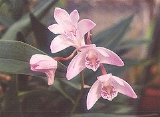
Dendrobium
Overview
Dendrobium is a huge genus
of orchids. It was established by Olof Swartz
in 1799 and today contains about 1,200 species
. The genus occurs in diverse habitats throughout much of south, east and southeast Asia
, including the Philippines
, Borneo
, Australia
, New Guinea
, Solomon Islands and New Zealand
. The name is from the Greek dendron ("tree") and bios ("life"); it means "one who lives on trees", or, essentially, "epiphyte
".
In 1981, Briegar reclassified all terete-leaved Dendrobiums from Australia and New Guinea into a new genus, Dockrillia
.
Genus
In biology, a genus is a low-level taxonomic rank used in the biological classification of living and fossil organisms, which is an example of definition by genus and differentia...
of orchids. It was established by Olof Swartz
Olof Swartz
Olof Peter Swartz was a Swedish botanist and taxonomist. He is best known for his taxonomic work and studies into pteridophytes...
in 1799 and today contains about 1,200 species
Species
In biology, a species is one of the basic units of biological classification and a taxonomic rank. A species is often defined as a group of organisms capable of interbreeding and producing fertile offspring. While in many cases this definition is adequate, more precise or differing measures are...
. The genus occurs in diverse habitats throughout much of south, east and southeast Asia
Asia
Asia is the world's largest and most populous continent, located primarily in the eastern and northern hemispheres. It covers 8.7% of the Earth's total surface area and with approximately 3.879 billion people, it hosts 60% of the world's current human population...
, including the Philippines
Philippines
The Philippines , officially known as the Republic of the Philippines , is a country in Southeast Asia in the western Pacific Ocean. To its north across the Luzon Strait lies Taiwan. West across the South China Sea sits Vietnam...
, Borneo
Borneo
Borneo is the third largest island in the world and is located north of Java Island, Indonesia, at the geographic centre of Maritime Southeast Asia....
, Australia
Australia
Australia , officially the Commonwealth of Australia, is a country in the Southern Hemisphere comprising the mainland of the Australian continent, the island of Tasmania, and numerous smaller islands in the Indian and Pacific Oceans. It is the world's sixth-largest country by total area...
, New Guinea
New Guinea
New Guinea is the world's second largest island, after Greenland, covering a land area of 786,000 km2. Located in the southwest Pacific Ocean, it lies geographically to the east of the Malay Archipelago, with which it is sometimes included as part of a greater Indo-Australian Archipelago...
, Solomon Islands and New Zealand
New Zealand
New Zealand is an island country in the south-western Pacific Ocean comprising two main landmasses and numerous smaller islands. The country is situated some east of Australia across the Tasman Sea, and roughly south of the Pacific island nations of New Caledonia, Fiji, and Tonga...
. The name is from the Greek dendron ("tree") and bios ("life"); it means "one who lives on trees", or, essentially, "epiphyte
Epiphyte
An epiphyte is a plant that grows upon another plant non-parasitically or sometimes upon some other object , derives its moisture and nutrients from the air and rain and sometimes from debris accumulating around it, and is found in the temperate zone and in the...
".
In 1981, Briegar reclassified all terete-leaved Dendrobiums from Australia and New Guinea into a new genus, Dockrillia
Dockrillia
All terete leaved Dendrobium species from Australia and Papua New Guinea have been moved into a newly created genus, Dockrillia, named after Alick Dockrill, a contemporary Australian orchidologist...
.
Unanswered Questions
Discussions

